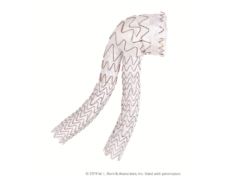
Females were found to be at greater risk of reintervention following elective endovascular aneurysm repair (EVAR) for abdominal aortic aneurysms (AAAs) at both the one- and five-year mark following their initial procedure, researchers in New Jersey discovered.
The retrospective chart review conducted by first-named author Taylor Corsi, BS, a medical student at Rutgers Robert Wood Johnson Medical School in New Brunswick, senior author William Beckerman, MD, a vascular surgeon at Robert Wood Johnson University Hospital, and colleagues showed freedom from reintervention rates of 86% for females vs. 96% for males at one year (p=0.02) and 69% (female) vs. 86% (male) at five years (p=0.03).
Delivering the data at the recent Eastern Vascular Society (EVS) annual meeting (Sept. 23–26; Charleston, South Carolina), Beckerman told attendees the findings “support recent conclusions that, despite similar one- and five-year mortality, females do have a higher rate of early and long-term postoperative morbidity such as reintervention.
“This refutes the suggestion that comparable outcomes using a single device and trial inclusion criteria can be applied broadly.”
The Rutgers data, from 2011 to 2016, include 185 patients—75% of them men, with 25% women. The research team looked at primary outcomes of survival along with freedom from reintervention at one and five years. Secondary outcomes analyzed were postoperative intensive care unit (ICU) stay and 30-day readmission.
The researchers found no statistically significant difference in postoperative ICU stay or 30-day readmission rates between the sexes but a trend toward significance in terms of more females requiring an ICU stay after their initial operation. Similarly, they did not detect a statistically significant difference in one- and five-year survival rates.“Looking at reintervention, we did see a difference at both one and five years in terms of freedom from reintervention between males and females, with females having a greater risk of reintervention at both of these time points,” Beckerman explained.
“With the reinterventions, there was a little bit of a drop right from the beginning, which was associated with more access site complications in females, whether that was in the iliac artery in terms of dissections, thrombosis or from the common femoral access, whether percutaneous or open. As time went on, it mostly trended toward an endoleak intervention as a cause for reintervention in these patients.” On multivariate analysis, female sex alone predicted increased five-year risk of reintervention (p=0.02), Beckerman added.
He concluded: “Female sex was independently associated with one- and five-year reintervention and not survival. We did find that there were sex-specific factors that contributed to greater surgical morbidity after elective EVAR. This is one of the only studies to our knowledge that utilizes the full depth of institution-specific data with five-year follow-up. And it provides real-world evidence in support of a need to study devices in a more heterogenous population, especially getting more women enrolled in trials for these devices.”
Beckerman conceded limitations, including the fact the data were drawn from a few hundred patients at a single tertiary care center. He said the research team intends to study more recent patients to account for the development of smaller devices and also plans to collaborate with non-tertiary care centers “to better evaluate representative outcomes.”
Speaking from the audience, incoming EVS President Robert Y. Rhee, MD, pointed out the preponderance of men in investigational device exemption (IDE) trials, which, depending on the subset, can consist of 80–90% men, he said. Beckerman added: “No one is expecting a 50-50 split just because there is not a 50-50 split in terms of aneurysms being treated in women vs. men but it would be nice to see, at the very least, a study population that is equivalent to the population that is being treated.”












